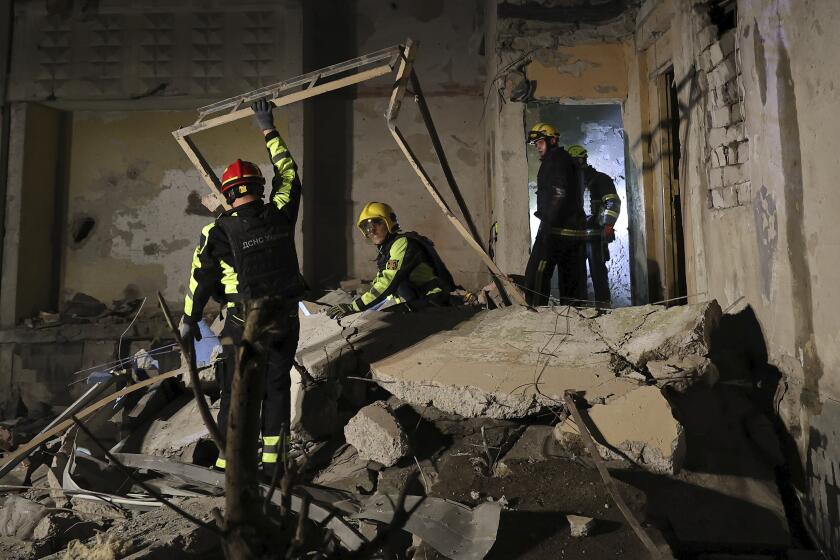Haditha deaths were seen as combat-related
Defending the lack of a war-crimes investigation in the killing of 24 Iraqi civilians in Haditha, a Marine intelligence officer testified Wednesday that it appeared the deaths had occurred in the midst of a series of attacks by insurgents that Marines had been strongly warned to anticipate.
Capt. Jeffrey Dinsmore said that Marine officers decided the deaths were combat-related and thus no investigation was warranted. His testimony came during an Article 32 inquiry, similar to a preliminary hearing, for a former battalion commander.
In a sometimes bitter exchange with prosecutors, he denounced the Marine Corps for charging Lt. Col. Jeffrey Chessani with dereliction of duty.
“Politically, the Marine Corps made a decision to hang Col. Chessani out to dry,” said Dinsmore, who has served for 20 years and is now deployed to Iraq. He added that he feels the investigation is hurting the corps.
The military began an investigation of the Nov. 19, 2005, killings only after Time magazine began questioning the Marines’ assertion that the civilians had been killed in crossfire between Marines and insurgents.
Dinsmore, in testimony that was videotaped earlier this year, said Marines had developed intelligence prompting them to prepare for a complex attack involving roadside bombs and small-arms fire, with insurgents hiding among civilians in their homes.
The events seemed to fit that pattern, he said: A bomb exploding under a Humvee and a nearby firefight that erupted after Marines stormed three houses and killed 19 civilians inside.
With an increasing tone of incredulity, Lt. Col. Sean Sullivan, the lead prosecutor in the Article 32 inquiry for Chessani, repeatedly asked Dinsmore whether he had requested a report on the deaths of 24 civilians in the Haditha incident.
“No, sir,” Dinsmore answered.
Chessani is accused of failing to launch a war crimes investigation of the deaths of five men outside their car as well as three women, seven children and nine men inside the three houses.
All were killed by Marines from Chessani’s 3rd Battalion, 1st Regiment. Dinsmore was the lead intelligence officer for the battalion and was involved in developing reports for superiors on the day of the killings; he has not been charged in the case.
Three days after the killings, Maj. Gen. Richard Huck, then commander of the 2nd Marine Division, came to the central Iraqi town for a routine update.
Huck, who also has not been charged, testified last week that after he saw a slide show put on by battalion officers, he was satisfied the deaths were combat-related. Dinsmore testified that Huck congratulated the Marines for repulsing attacks.
The bloodshed began early in the morning when a roadside bomb exploded beneath a Marine convoy, killing a Marine. In short order, fellow Marines killed five men outside their car and were ordered to “clear” houses nearby, resulting in the 19 other deaths.
Marines had told their platoon commander that they had heard gunfire from the direction of the houses, although no weapons or shell casings were found in or near the car nor in the houses, according to testimony.
Within minutes of the Humvee blast and house-clearing, another group of Marines was engaged in a firefight about 1,000 yards away in a palm grove. That battle left numerous troops wounded and ended with the Marines calling for an airstrike.
As they later reconstructed the events of the day, Marines were convinced that the bombing and the firefight in the palm grove were part of the same attack, Dinsmore testified.
Two or three days before the killings, Marines had learned that fighters from Syria were in Haditha, waiting to ambush them, Dinsmore said.
After Humvee blast, Marine officers called for an aerial drone to scan the scene. Once it arrived, the firefight at the palm grove was underway, officers have testified.
Among other things, the drone broadcast a picture of an insurgent who had been involved in the palm grove firefight running into a nearby house and emerging with different clothing and carrying a baby.
With that image in mind, officers decided that it was logical that insurgents had been hiding in houses and firing on Marines after the explosion that killed Lance Cpl. Miguel Terrazas.
Prosecutors have suggested that the Marines, wary as a result of their intelligence reports, may have only imagined that they were being fired on after the Humvee was attacked.
Staff Sgt. Frank D. Wuterich, the squad leader who led the house-clearing, told his platoon commander that Marines had used grenades inside the houses after hearing AK-47s being prepared for firing and after taking fire from an insurgent, platoon commander 1st Lt. William Kallop testified this week.
Wuterich is one of three enlisted Marines charged with murder. Four officers are charged with dereliction of duty.
--
More to Read
Sign up for Essential California
The most important California stories and recommendations in your inbox every morning.
You may occasionally receive promotional content from the Los Angeles Times.









